|
|
FANTASY ISLAND
Story written by Rick Archer
Pictures contributed by Milt Oglesby
Original Story:
May 2008
Last Update: February 2009
One of the most popular vacation and retirement fantasies is
the island home away from it all. Many people love the
water. For example, although I am more
of a Colorado mountain guy myself, my wife tells me a house
on the ocean would work just fine for her.
|
 |
As you will soon see, this article
will display a mouth-watering
cabana built out into the water next to some small island in the middle of
the Pacific Ocean. I am not sure where this island is. My friend Milt sent me
the pictures, but there was no accompanying information as
to the origin of the shots.
Rumor has it that Tahiti has many locations
like the pictures you are about to see. Hopefully some
snooping around the Internet will turn up more information.
Yes, that rumor is confirmed! As you can see, Tahiti
has lots and lots of cabanas with thatched roofs out in the
water.
 |
Tahiti, Queen of the Pacific
Tahiti, often called the island of love, is the
largest of all French Polynesian islands. Deep
valleys, waterfalls cascading into cool rivers and
streams hide between the beautiful mountains,
overlooked by majestic peaks. The flat coastal
lands, are planted with fields of tropical flowers
and home to most of the island's population.
Tahiti's beaches vary from black sand beaches on the
north east coast and white sand beaches on the south
west coast. Papeete, the capital, is the place to
shop for authentic souvenirs at the great local
market.
Bora Bora, the Romantic
Island
Bora Bora island is possibly the most famous island
in the world
(Rick Archer's Note: I
doubt seriously that Bora Bora is the most famous
island in the world). Lush tropical rainforests, white sand
beaches and palm covered motu surrounding the island
and the gorgeous azure lagoon, make this island the
perfect nest for romantics and honeymooners... Bora
Bora is love at first sight.
Moorea, the Bay Island
Crystalline lagoons, home of dolphins and rays.
Waterfalls tumble down the steep pineapple covered
mountains. Volcanic peaks rise high above the
tranquil waters of Cook's Bay and Oponohu Bay.
Peaceful meadows and gardens of hibiscus, birds of
paradise and many more exotic plants will renew your
belief in the majesty of nature. Less than ten
minutes away by air from Tahiti, Moorea is ideal for
a day's visit.
Huahine, Garden of Eden
Huahine, picturesque, with its lush rainforests,
rich and fertile soil growing abundance of vanilla
and bananas on the slopes of a very diverse and
dramatic geography, is one of Polynesia's best kept
secrets. A scenic road winds around the two small
islands that compose Huahine, through charming
villages, beautiful vistas of crystal-clear lagoons,
rich with sea life, where lie motu islets bordered
by white sand beaches and coconut trees. Maeva
village is a wealth of archeological sites that go
back to 1000 years. The spell cast by Huahine will
last a lifetime.
Raiatea and Taha'a
Far less traveled then Bora Bora or Moorea, these
two sister islands offer an experience of a true
unspoiled Polynesia. They share a wonderful lagoon
rich in sea life, and ideal for sailing, scuba
diving and outrigger canoeing.
Taha'a, filled with a rich aroma of vanilla
lingering in the air, is "The Vanilla Island". This
flower shaped island charms us with the simple
beauty of its soft mountains and surrounding of tiny
motu on the endless lagoon. Taha'a still maintains
an authentic flavor of Polynesia.
Rangiroa
Life on these remote atolls is simple and normally
quiet and peaceful. In the small villages the
visitor can discover the true flavor of the Tuamotu,
often participating in the daily activities of the
Paumotu people. The interior lagoons are a haven for
black pearl farms, fish parks, snorkeling and scuba
diving.
Tikehau, Remote, Beautiful,
Magical
Tikehau, considered to be one of the most beautiful
atolls of Polynesia, is a graceful crown of
pink-sand beaches. In this pristine world, fish seem
to outnumber people. The interior lagoons are a
haven for black pearl farms, snorkeling, exploring
the Isle of Birds and enjoying endless hours of
kayak ballads encountering rays, exotic fish and
coral gardens. The local people, friendly
inhabitants of the small village of Tuherahera,
invite you to share their world beyond imagination.
 |
 |
Now that we have taken a look at
Tahiti and studied the architecture of the cabanas, let's
turn our attention to our own "Fantasy Island". As
you can see, the first glance at our Fantasy Island carries
a serious "Wow" punch! Talk about luxury in the middle
of nowhere!
|
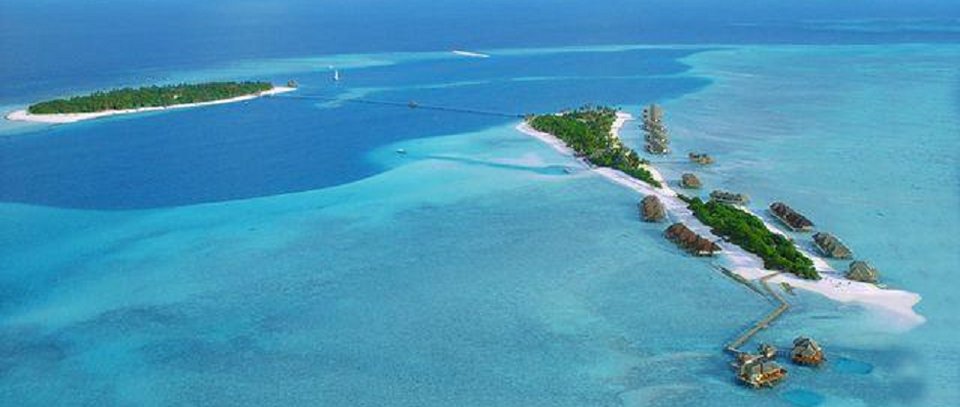 |
By the way, we are going to
revisit this same picture
later in the article.
Back to later section
of article.
|
|
The light blue indicates shallow waters.
The dark blue is deeper waters.
If you look
carefully, you will notice a long bridge connecting the two islands together.
There appears to be about 20 cabanas surrounding the long slender
island with two trophy homes set apart at the end. Note the
long walkway out to the trophy homes. These homes are built completely
out in the water.
 |
These are the same two islands, but from a
different perspective. Now we are looking at the larger
island. With this close-up, we can see the larger island has cabanas
too, except that most of appear to be on the island. Wherever
you see brown, those are cabana roof tops. Is that a
spot of blue in the middle of the island next to the clearing? Is that a swimming pool?
Maybe this island has been developed as a resort.
The water appears to be very shallow. It looks like the
bridge crosses a third island lying just below the water. Also note at the
top of the picture what appears to be a man-made protective barrier.
You have to wonder how long these two islands would hang
around with global warming. Watch a couple Antarctic glaciers
melt and these islands might just be marked for extinction.
But for now they serve as Fantasy Islands for the rich.
 |
And now we come to our Trophy Homes. Studying
both islands, I believe these homes are attached to the long slender
island. Do you see the two blue squares in front of the
stairs? Those squares are likely man-made. I assume these
areas are used for docking purposes. Wonder what the
explanation is for those two squares? Anyone have an idea?
Here is our first close look at one of
the cabanas.
Studying the architecture, wouldn't you agree our cabana hut
has "Tahitian" written all over it?
I don't think this picture is one of the trophy homes.
It looks too small to be one of the two structures in
the picture above it.
I see only one roof here. The larger homes have three rooftops.
But on the other hand this smaller cabana does have a walkway. Are there
other rooftops hiding behind the roof we can see?
I don't
think so. My conclusion is this is a
different structure than the two Trophy homes.
Maybe you can figure it out.
Meanwhile this deck appears to belong to the house
with one roof.
|
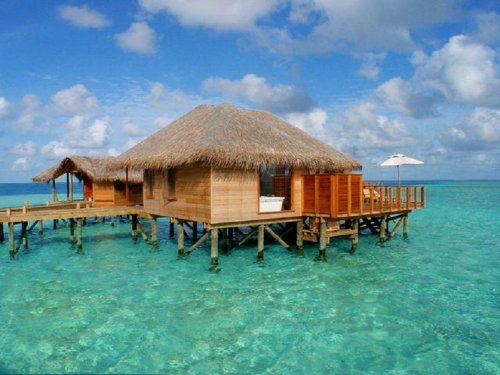 |
 |
This lovely view appears to be part of
the smaller cabana in the previous picture above. The
wood is the same color and the umbrella seems to be the same
as well. Is that a hot tub
on the left?
Note the square bed inside the cabana. I will refer back to
it in a moment.
|
Here we have a massage table with a
see-through floor. This allows you to look at fish swimming by while
you scream in pain. This lends more weight to the 'resort idea'.
Private homes don't typically have massage tables. In the
second picture that looks like a flat-screen TV and a jacuzzi/bath
tub. There is a ceiling fan as well. Conclusion: There must be
electricity! The electric wires are probably disguised by
attaching them to the side of the walkway.
By the way, as you can see the bed is round. However in the
previous picture the bed was rectangular. Conclusion? We
are looking at pictures of two different structures.
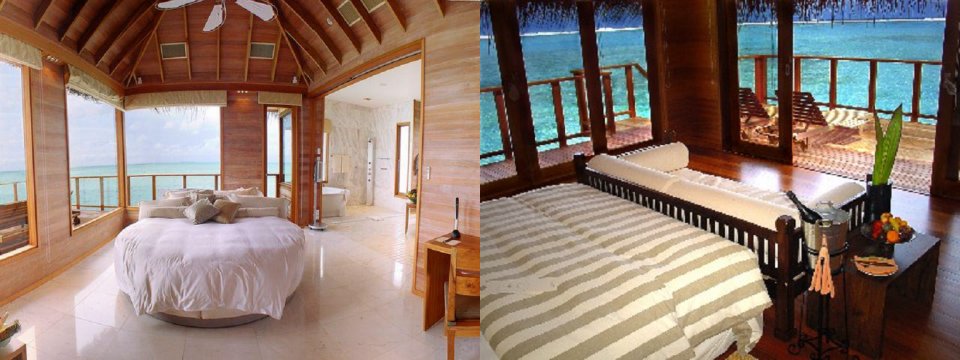 |
Here is more evidence to support the
theory of two different structures. Here is the round
bed and the square bed. One room has light wood; one room
has dark wood. They are probably adjacent cabanas.
|
 |
Now that's pretty cool - three stingrays
right below the deck! Three stars on the Wow factor.
And how about having a living room with a see-through floor
- three more stars on the Wow factor! Fun.
I am still curious to know if these are
places to live or places to visit. The simple
furnishings indicate these cabanas are 'visited'. They
don't have that 'lived in' look. The cabanas are elegant, but very spare.
Note that one woman has a drink in her hand while there is a
champagne bottle on ice in the other. I don't have any
champagne on ice in my home. I believe these are
resort advertisement pictures.
|
 |
These two pictures definitely show
different structures. There is a triple roof on the
left and single roofs on the right. The left is an
elaborate dwelling while the right seems to be dwellings on
a more simple scale with much different construction in the
stilts below.
This lends more evidence to the theory that our pictures are
from at least two, maybe even three different structures.
So what is going on here?
THE OBNOXIOUS POWER
PRESENTATION
One day in April 2008 I received an email from
Milt Oglesby that included a Power Point presentation. Milt didn't
have a clue as to the origin of the Powerpoint, by the way. Many of
the pictures I have published - including the RV and the yacht - were enclosed in
the PowerPoint
presentation.
The PowerPoint was scripted as a 'pretend' invitation to attend a
luau at the homes in the pictures above. The whole point of the presentation was to make
people envious as all get-out. As for me, it was successful. I
openly lusted for the chance to spend time in one of those cabanas
and see a part of the world totally foreign to me.
There was something odd about the PowerPoint
though. It included that picture of an RV to pick you up at the
airport and that magnificent yacht to bring you to the luau on these
islands.
The more I thought about it, the more I decided the PowerPoint was
blowing smoke. For one thing, I can't imagine an RV picking
people up in Tahiti. Second, I can't imagine a massive yacht
operating in these shallow waters. Plus there was the
curiosity of pictures from two or more different cabanas that didn't
seem to match.
That is why I concluded the PowerPoint itself was made by someone
who is poor like you and me. They simply collected the images
on the Internet from some 'Tahitian Vacation' web site and spliced
them together. I imagine the bloke didn't have enough cabana
pictures of one home, so he (or she) simply used pictures of several
different structures.
|
 |
 |
That said, I still thoroughly enjoyed
the pictures. And knowing the truth helped my envy
calm down a little. Still, it's fun to dream.
So what do you think? Are you ready to settle down on
Fantasy Island? Is this a valid Retirement Fantasy?
Want to spend the rest of your life watching fish float by? Or would you rather
just drop in for a visit sometime?
One thing for sure - this place definitely qualifies as a
Tropical Paradise.
|
2009 UPDATE:
OOPS! CHANGE THAT TO 'MALDIVE
ISLANDS'! |
|
 |
 |
In February 2009 I received an email that
changed my perspective from Tahiti to the
Maldive islands south of India.
|
From: Blake
Sent: Sunday, February 01, 2009 10:29 AM
To: dance@ssqq.com
Subject: Fantasy
Island
G'Day Rick, my
names Blake and I'm from Australia, I have
been surfing some of your interesting write
ups even the stuff up with the sultans
palace. lol. Anyway like what you do but I
thought I would inform you that some of your
fantasy Island photos are of a place called
the Maldives.
The Maldives are a bunch of Islands
so small they don't appear on the world map,
(guessing invisible from space).
They are located below India and Sri
Lanka slightly to the South West.
Many of the hotels and accommodation is
built in the water mainly because there
isn't enough room left
on the island!
Sadly this area of the ocean is also the
Tsunami area
My partner and I are travelling there later
this year and its not as expensive as you
would have thought, although I haven't any
figures for you.
We live on a modest budget and find
it affordable. Perhaps
it is cheaper in flights due to location of
Perth, Australia? Dunno
The photos are exactly the same as the ones
you posted with one roof and a walkway that
slightly confused you. I think who ever is
sending you these "photo packages" is mixing
things up a bit.
Laddahs!
|

This lovely place in the
Maldives is known as "Full Moon Island"
|
Rick
Archer's Note:
Following Blake's suggestion, I brought up
"Google Images" for the Maldive Islands.
Sure enough, I saw several of the same
pictures I had used for my "Tahiti" writeup
including the picture on the right.
"Many of
the hotels and accommodation is built in
the water mainly because there isn't
enough room left
on the island!"
As you will see from
the pictures, Blake's comment made a lot of
sense.
Maldive Islands
The Maldive Islands
are an island nation consisting of a
group of atolls stretching south of India in
the Indian Ocean. The twenty-six atolls of
Maldives encompass a territory featuring
1,192 islets, of which two hundred and fifty
islands are inhabited.
The Maldives is the smallest Asian country
in terms of both population and area; it is
the smallest predominantly Muslim nation in
the world. With two meters from sea level,
it is also the country with the lowest
"highest point"
in the world.
The Maldives holds the record for being the
lowest country in the world, with a maximum
natural ground level of only 7½ feet.
The average height
is only 5 feet
above sea level, though in areas where
construction exists this has been increased.
Rising Sea Waters
On April 22, 2008, then Maldives
President Maumoon Abdul Gayoom pleaded for a
cut in global greenhouse gas emissions,
warning that rising sea levels could
submerge the island nation of Maldives.
Over the last century, sea levels have risen
about 8 inches. Further
rises of the ocean could threaten the
existence of Maldives. However, around 1970
the sea level there dropped
significantly, so the
future is uncertain. In
November of 2008, President Mohamed Nasheed
announced plans to look into purchasing new
land in India, Sri Lanka, and Australia, due
to his concerns about global warming and the
possibility of much of the islands being
inundated with water from rising sea levels.
Current estimates place sea level
rise at 25 inches
by the year 2100. The purchase of land will
be made from a fund generated by tourism.
The President has explained his intentions,
saying "We do not want to leave the
Maldives, but we also do not want to be
climate refugees living in tents for
decades".
The
2004 Tsunami
A tsunami in the Indian Ocean caused
by the 2004 Indian Ocean earthquake caused
serious damage to the socioeconomic
infrastructure which left many people
homeless, and irreversible damage to the
environment. After the disaster,
cartographers are planning to redraw the
maps of the islands due to alterations
caused by the tsunami.
Ecology
The reef is composed of coral debris and
living coral. This acts as a natural barrier
against the sea, forming lagoons. Other
islands, set at a distance and parallel to
the reef, have their own protective fringe
of reef. An opening in the surrounding coral
barrier allows access to the calmer lagoon
waters.
The barrier reefs of the islands protect
them from the storms and high waves of the
Indian Ocean. The Indian Ocean has a great
effect on the climate of the country by
acting as a heat buffer, absorbing, storing,
and slowly releasing the tropical heat. The
heat is further mitigated by cool sea
breezes.
A layer of humus forms the top layer of soil
on the islands. Below the humus layer are
two feet of sandstone, followed by sand and
then fresh water. Due to excessive salt in
the soil near the beach, vegetation is
limited there to a few plants such as
shrubs, flowering plants, and small hedges.
In the interior of the island, more
vegetation such as mangrove and banyan grow.
Coconut palms, the national tree, are able
to grow almost everywhere on the islands and
are integral to the lifestyle of the
natives.
The limited vegetation is supplemented by
the abundance of coral reefs and marine
life.
Tourism
Due to the beauty
of the islands, tourism has now grown to 20%
of the Maldive economy.
|
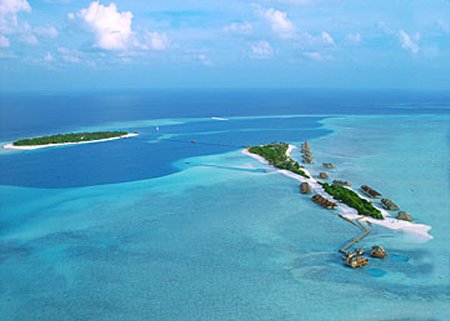
The
picture above was identified as some of the
Maldive Atolls. Now
go
see an
earlier picture for comparison. I think it is
the exact same picture.
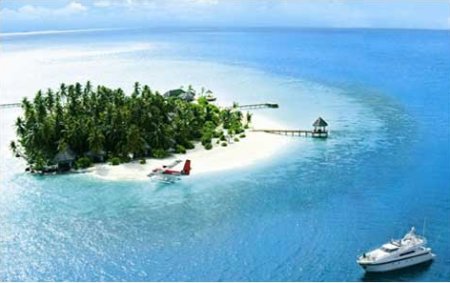


 |

The Maldives and the Tsunami
This area is often promoted as the last
paradise on Earth, but the Maldives and its
precious tourism industry were devastated by
the December
2004 tsunami. Inaccessibility of some
islands hampered repair schedules
The island nation's economy relies
more heavily on tourism than any other
tsunami-affected country.
Nowhere else is more aware of the
threat posed by rising seas than the
Maldives.
About 99% of its territory is sea -
and on the 1,200 low-lying coral islands
that straddle the equator, nowhere is more
than one-and-a-half metres above sea level.
The country campaigns against the effects of
climate change to protect its very survival,
but the tsunami made it face its worst
fears.
A total of 49 inhabited islands were flooded
and one-quarter of the 87 resort islands
were put out of operation and are now
undergoing repairs.
The tsunami cost 82 lives, with another 20
locals still missing.
The death toll may sound small when compared
with other affected countries - but this is
a nation of only 300,000 people.
Many here rely on tourism. It provides
two-thirds of employment and the largest
proportion of GDP.
It may seem at odds staying at a luxury
resort while local communities struggle to
get back on their feet, but with bookings
down 50%, the Maldivians want tourists back.
"The tourist dollars do help in the recovery
and rehabilitation of people and this is our
lifeline, so if it's disrupted it aggravates
the situation," says Hassan Sobir, the
Maldives High Commissioner in Britain.
"Fortunately, because of the geography -
maybe sheer luck - many islands have been
spared in terms of damage."
Scientists say the archipelago was spared
the full force because the huge coral reefs
that encircle the islands absorbed much of
the impact - as did breakwaters built around
the capital, Male, after previous flooding.
The set-up in the Maldives is an unusual
one.
A one-resort-per-island policy separates
guests from locals and from other tourists,
giving a sense of isolation that is one of
the Maldives' main selling points.
Central to this strategy is that each island
is self-sufficient, generating power, waste
management and water supply.
It means the usual risk of water
contamination and disease that often follow
disasters has largely been avoided.
It also means repairs will be localized.
However, rebuilding these remote islands,
accessible only by seaplane or boat, will
take months and cost an estimated $1.5bn.
Despite the crisis, the government still
plans to develop 11 new island resorts over
the next two years.
Hoteliers like Francois Huet, the general
manager of the Banyan Tree Hotel, welcome
the move.
"It's an opportunity to develop different
kinds of competition to stimulate the
market," he says.
The Maldives does not have a long history as
a tourist destination - just three decades -
during which it has moved to the top of the
luxury holiday lists, is a favourite for
honeymooners and a premier dive location.
When the first hotel, Kurumba, opened in
1972 it was very basic.
Its founder is often credited with
kick-starting the tourism industry.
Back then there were only 1,000 tourists a
year. Last year, there were more than
500,000.
Mohamed Umar Maniku built Kurumba and is now
chairman of the resort development company,
Universal Enterprises.
"When we started there were already three
big destinations in Asia - Sri Lanka,
Thailand and the Seychelles.
"We never had anything and so we thought if
they can be successful, why not us?"
Developing tourism has also helped raise
environmental concerns.
Some hotels like the Banyan Tree and Angsana
have green funds where they match guest
donations of one dollar a night for
conservation projects.
Those contributions have now been doubled
and are going towards tsunami recovery.
Staff are also donating part of their
salary.
And on the island of Fen Fushi, children
learn about protecting marine life while
their parents all work at the nearby resort
Sun Island.
Bringing tourism and nature together is not
only their future, but also that of the
Maldives.
|





 |
|
MORE PHOTOS OF LUXURY CABANAS
IN THE MALDIVES
|
 |
 |
 |
 |
 |
 |
About these Pictures:
In May 2009, a gentleman named Ken
emailed to tell me about these
beautiful pictures.
I believe the pictures are taken
from a resort island known as
Huvafen Fushi. If you
interested, you should visit
www.atollparadise.com or
simply click
Huvafen Fushi
|
|
| |
|
 |
 |
|
Rick Archer's Note: Tahiti, Maldives, what's the
difference? Either way I am miserable with envy.
You would be miserable too if you lived where I do. I
am stuck in Houston, Texas, USA, the heat and
flooding capital of the world,
Here are the two most famous recurring
images of my hometown:
|
Tropical Storm
Allison June 2001:
Worst Urban Flood in US History
 |
| |
|
|
Rita evacuees from
Houston Texas September 2005:
Worst Traffic Jam in US History
 |
| |
|
In parting, the PowerPoint presentation reminded me of one
of my favorite jokes about Paradise. If you would like
to read the Genie and the Law Firm, Scroll
down a little.
|
|
 |
 |
The Genie and the Law Firm
A secretary, a rookie lawyer just out of law school, and
a partner in a big city
law firm are driving to lunch. The traffic is ridiculous and they
haven't moved five feet in five minutes. Noticing a parking spot
next to a city park, the law partner orders the first-year
man to pull over.
The high-powered attorney barks at the
other two and says it would be quicker to simply walk.
Then he looks at his watch and frowns. Addressing his
secretary, "What does my afternoon look like, Sarah?"
Worried she's about to miss lunch, Sarah squirms a little.
Finally she admits, "You have one appointment after another, Mr.
Jones."
The law partner fumes, "That's what
I thought. Damn, it's late! We
are wasting valuable time! Let's get moving, people."
|
Jeff, the first-year lawyer, points to the city
park. Jeff suggests, "Sometimes I walk to lunch. I know
a short-cut through this park."
The law partner snorts and says the rookie
lawyer better be right or he'll take any further wasted time out of
the kid's salary.
So they walk through the park on their way to lunch.
Jeff, the over-worked first-year
lawyer, is so preoccupied with his
massive workload that he pays little attention to where he is going.
Suddenly Jeff trips over some
object buried in mud on the side of the trail.
Jeff kicks up an antique oil lamp.
Sarah the secretary exclaims, "Oh,
how pretty! That looks like Aladdin's lamp! I
can't wait to polish it off and put it on
my desk!" Sarah rubs
the lamp gently to clean the mud
off a bit. Suddenly...
Poof! Shazaam!
A Genie comes out in a puff of
smoke.
The Genie takes a look, then says, "I'm glad to see you. I
have been stuck in that lamp for a
thousand years. But
I have a problem. I can only grant three wishes
and you are three. Therefore I will grant
you each one
wish."
|
 |
 |
"Me first! Me first!" says Sarah the
secretary. "I read travel magazines all the time.
I know exactly what I want! I work year-round,
put in lots of unpaid overtime, and never call in sick, but I
am still too broke to go anywhere fun."
Sarah pauses for effect. She is hoping the partner will
realize she is underpaid and overworked. But the partner
doesn't blink. So Sarah continues, "I want to be in the
Bahamas laying in a hammock on the beach with my boyfriend
without a care in the world!"
Poof! Sarah's gone! She
has vanished before their very eyes.
|
At Sarah's sudden disappearance, the rookie
lawyer's eyes bulge in disbelief. He is astonished.
It takes Jeff a moment to accept this incredible opportunity is
real.
Taking a deep breath, the first-year
lawyer says, "Since I joined the law firm, I have been working
80-hour weeks. I got married the moment I finished law school, but
ever since I started working here I barely
see my wife at all. All I do is go home,
pass out, and get back up at 6 am to come to the office practically
seven days a week."
Jeff stops to think. "I miss my wife so much!
I would like to be alone with her
in Tahiti watching the sun set. We could live
together in one of
those straw roof bungalows
sipping silly
fruit drinks with umbrellas in
them!"
Poof!! Jeff is gone.
|
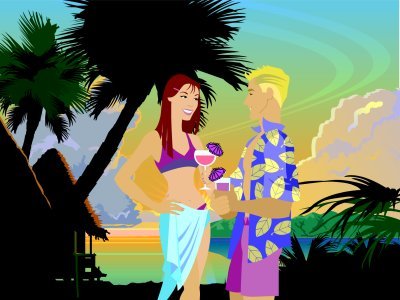 |
|
 |
Now that Sarah and Jeff have been whisked off to
Paradise with their loved ones, that leaves only the law partner and
the Genie.
As they stand alone in the park together, the Genie awaits his final
command. The partner is mulling something over.
"You're next," the Genie says to the law
partner.
Pressed for a decision, the partner looks
at his watch and frowns.
Then he looks up, curses under his breath,
and says, "Oh hell, give 'em 15 more
minutes."
"Then I want those two back in the office after lunch."
|
 |
|
|
|